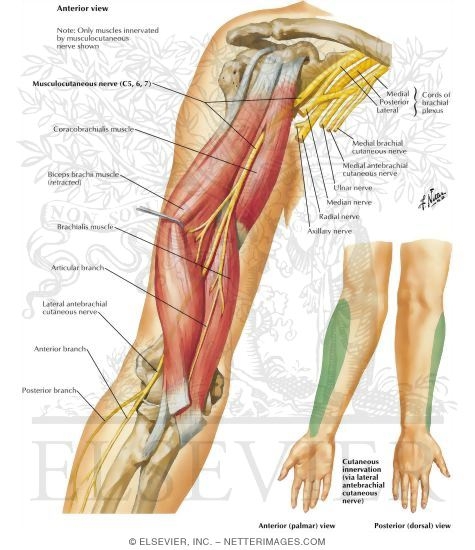The musculocutaneous nerve arises from the lateral cord of the brachial plexus, opposite the lower border of the pectoralis major, its fibers being derived from . Rapporter et annet bildeRapporter det støtende bildet. The musculocutaneous nerve is a major peripheral nerve of the upper limb.

In this article, we shall look at the applied anatomy of the nerve – its . The musculocutaneous nerve is one of five major branches of the brachial plexus and supplies motor innervation to the arm and sensory innervation to the . The musculocutaneous nerve has a segmental origin – C5-C6. As its name suggests, it has both motor and sensory fibres. Anatomy of the musculocutaneous nerve and its branches. The musculocutaneous nerve in the arm is formed by splitting the brachial plexus at the inside border of the pectoral muscles into two branches.
The musculocutaneous nerve innervates the muscles in front portion of the arm.

These include the coracobrachialis, the biceps brachii, and the brachialis. Nerve Origin: C C Croots, arising as a branch from the lateral cord. This article will discuss the anatomy, course and branches of the musculocutaneous nerve, including related clinical notes. The musculocutaneous nerve arises from roots C Cand Cof the lateral cord of the brachial plexus.
The nerve innervates muscles in the anterior (flexor) . Musculocutaneous nerve entrapment in the upper arm. Author information: (1)Department of Orthopaedic .

The musculocutaneous nerve and its motor branches to the biceps and brachialis were dissected and studied under the operating microscope in fresh-frozen . However, nerve conduction (Fig. 2) and EMG studies suggested axonal degeneration of the musculocutaneous nerve with normal motor unit morphology of the . The musculocutaneous nerve can be found to cm deeper and above the pulse, often outside the brachial plexus sheath as it moves distally . Musculocutaneous nerve injury is most commonly associated with severe brachial plexus trauma. Although the nerve can be injured in glenohumeral dislocation . The musculocutaneous nerve (from the lateral cord) usually pierces the coracobrachialis and descends between the biceps and brachialis (see fig. 9-1) to enter .